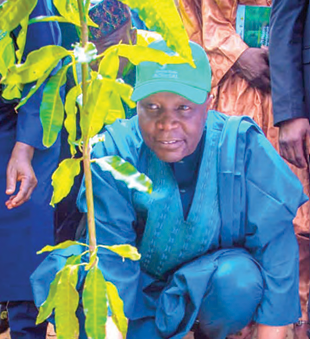As the world grapples with the increasingly severe consequences of climate change, Gombe State has emerged as a shining example, demonstrating exceptional leadership in environmental management.
The administration of Governor Muhammadu Inuwa Yahaya has recognized the urgency of addressing climate-induced challenges, particularly flooding and erosion, and has implemented a comprehensive strategy to mitigate their impacts.
By prioritizing sustainable practices and investing in critical infrastructure, the state has shown a strong commitment to the well-being of its citizens and the protection of the environment.
A cornerstone of the state’s strategy is the ambitious Gombe Goes Green ( 3G) programme which aims to plant at least one million trees annually across the state. Following the success of this initiative in planting about 4 million trees, the state government in collaboration with ACReSAL project, just few weeks ago flagged off 2024 tree planting exercise targeting over 1.7 million trees while reclaiming over 1900 hectares of degraded land.
This massive undertaking has yielded significant benefits, including improved air quality, soil conservation, and flood mitigation.
Trees act as natural barriers, absorbing rainwater and reducing runoff, thereby decreasing the likelihood of flooding. Additionally, they contribute to groundwater recharge, ensuring a sustainable water supply for the future.
To complement the tree planting initiative, the state government has invested heavily in infrastructure development. The government has embarked on large-scale control efforts. Notable projects include the 7.5-kilometer GSU to Unguwa-Uku gully erosion control project, implemented in partnership with the defunct NEWMAP, and the expansive 22-kilometer FCE(T) to Unguwa-Uku gully erosion control project. The latter project covers nine communities and is being carried out in partnership with ACReSAL, a World Bank-funded programme.
Furthermore, the government has constructed hundreds of waste collection centres throughout the state. This initiative has been instrumental in preventing flooding by reducing the amount of waste that ends up in drainage systems, a major contributor to blockages and waterlogging.
These centres play a crucial role in maintaining a clean and hygienic environment. They not only prevent flooding but also improve public health by reducing the breeding grounds for disease-carrying pests. The establishment of these facilities demonstrates the government’s commitment to a sustainable and resilient community.
As a tradition at the beginning of every rainy season, the government undertakes dredging and desilting of major flood drains. These activities have been instrumental in reducing the impact of flooding in Gombe State. By removing accumulated debris and sediments, these efforts improve the capacity of drainage systems to handle heavy rainfall, restore the natural flow of water bodies, and promote a healthy ecosystem.
These vital projects geared towards environmental sustainability have not only prevented further erosion but have also created jobs and improved the overall living conditions of the people.
By adopting a multi pronged approach that encompasses tree planting, waste management, drainage infrastructure, and erosion control, Gombe State has set a remarkable example for other regions grappling with similar challenges. The state’s efforts serve as a model for proactive planning and execution, showcasing the positive impact that can be achieved through strong leadership and a commitment to environmental well-being.
As the state continues its journey towards a greener future, it can serve as a model for collaboration, innovation, and community engagement in addressing climate change. By sharing its experiences and best practices, Gombe State can play a vital role in shaping a more sustainable future for Nigeria and the world.
–Suleiman writes from
Department of Geography,
Federal University of Kashere











